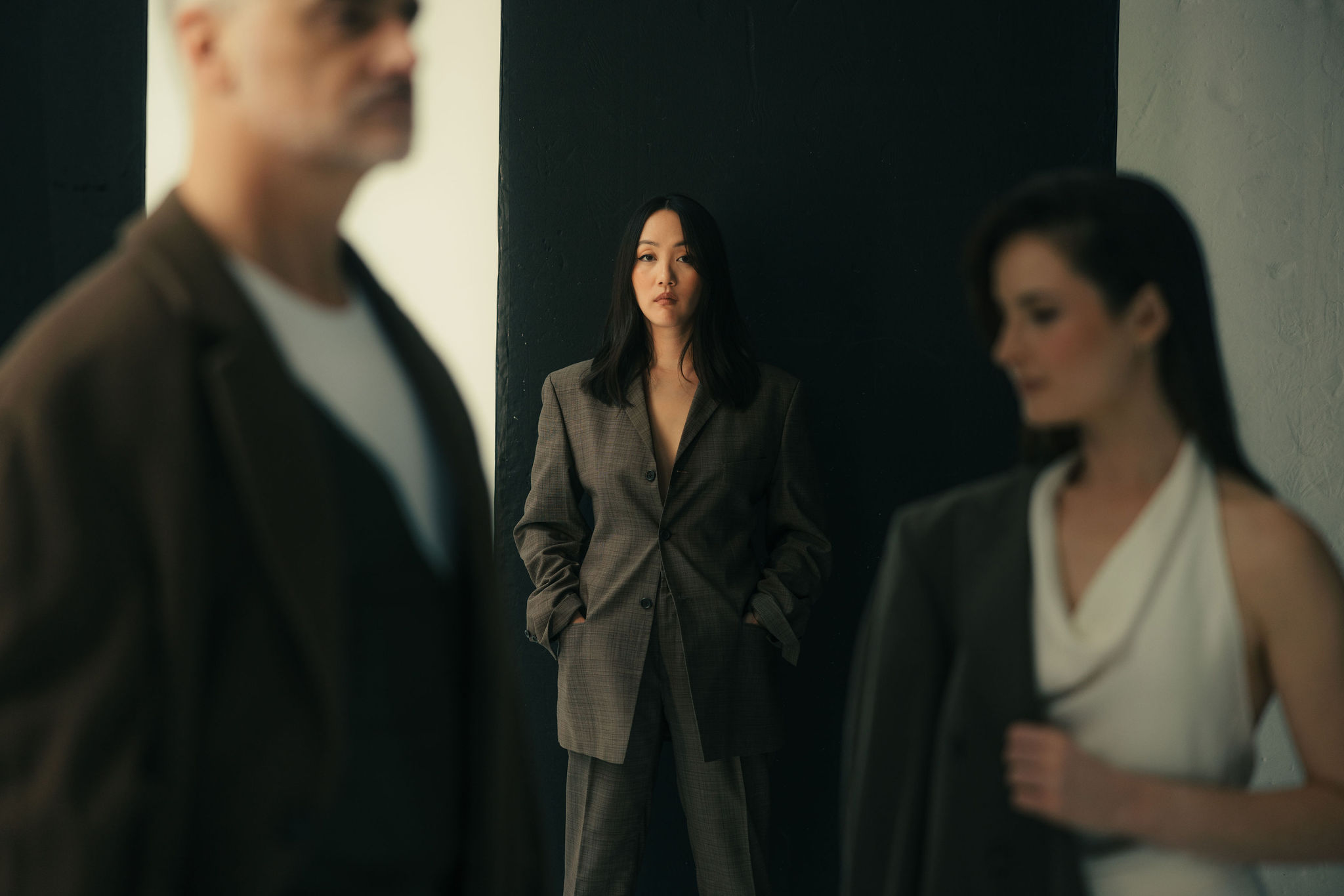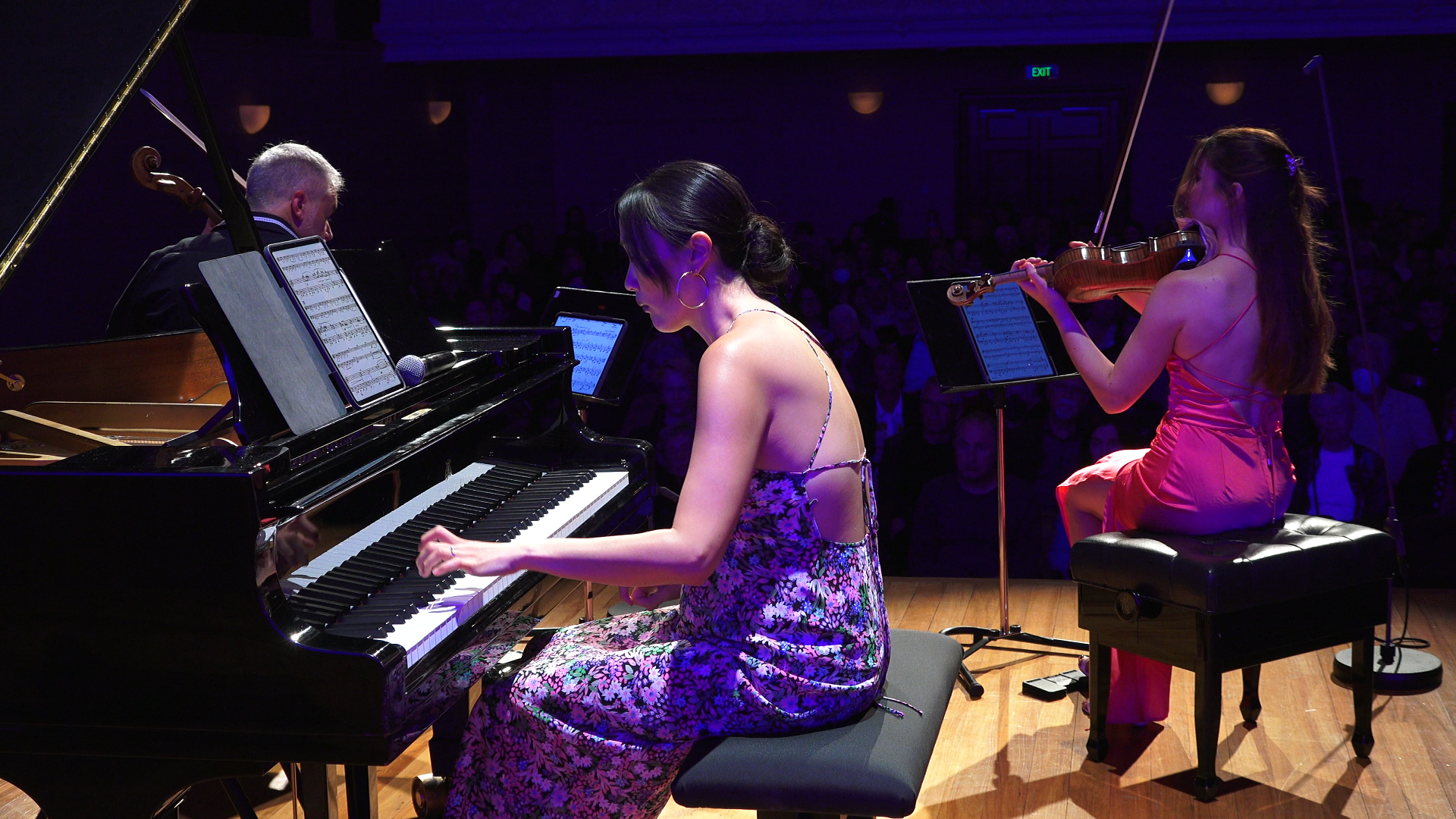Loft Series 3: Twine
11nov5:00 pm7:00 pmLoft Series 3: TwineAuckland Sunday performance
Event Details
Twine GLASS • SCHUMANN • HINDSON • ORAM • BRAHMS Ashley Brown (cello) with guest musicians Amalia Hall (violin) and Somi Kim (piano) In the finale of the series, Twine knits together
Event Details
Twine
GLASS • SCHUMANN • HINDSON • ORAM • BRAHMS
Ashley Brown (cello) with guest musicians Amalia Hall (violin) and Somi Kim (piano)
In the finale of the series, Twine knits together the linear sway from Philip Glass(USA) and the refreshing new pluck and spin from Matthew Hindson (AUS), with a new commission from Celeste Oram (NZ). Robert Schumann (GER) and Johannes Brahms (GER) deliver lashings of romantic sentimentality, outpourings from their lives entwined.
Programme 90 mins plus interval:
Philip Glass (USA): Mishima
Robert Schumann (GER): Piano Trio No.2 in F Major (movement)
Matthew Hindson (AUS): Rush
~
Celeste Oram (NZ): the naming of waters (new commission)
Johannes Brahms (GER): Piano Trio No.1 in B Major, Op 8
TICKETS: $50 Adults / $25 Students
Time
November 11, 2018 5:00 pm - 7:00 pm UTC+12:00(GMT+00:00)
Location
Loft at Q
Programme Notes
Philip Glass (USA; b. 1937): String Quartet No.3 (Mishima), c. 3’
vi. Mishima/Closing
Arranged for piano trio, this 6th and final movement from Glass’s String Quartet No. 3 is a tribute to Yukio Mishima – a deeply loved figure in his native Japan, and an important figure in the world. Poet, playwright, actor, director and author of over 30 novels, he was also a militant nationalist who on 25 November, 1970, plunged a dagger into his abdomen in a ritual act of Seppuku, despairing at the loss of Japan’s dignity in the Second World War and having failed in his attempt at a coup d’etat. This music comes from the Paul Schrader movie Mishima, A Life in Four Chapters: “The value of a man appears in the moment in which life confronts death”.
Born and raised in Baltimore, Glass studied at the University of Chicago, the Juilliard School and in Aspen with Darius Milhaud before heading to Europe in search of new sounds. He joins ranks with Aaron Copland, Virgil Thomson and Quincy Jones as understudies of the legendary pedagogue Nadia Boulanger and worked closely with composer Ravi Shankar. He returned to New York in 1967 where he formed the Philip Glass Ensemble. Glass prefers ‘repetitive structures’ over the often-used term ‘minimalism’ when describing his musical style. His vast body of work encompasses ensemble work, ten symphonies, more than twenty operas, two piano concertos, a wide range of film soundtracks and animation (Fantasia), popular music, and a growing body of work for solo piano and organ. He has collaborated with artists such as Twyla Tharp, Allen Ginsberg, Woody Allen, Linda Ronstadt, Yo-Yo Ma, Paul Simon and David Bowie.
Programme note by Charlotte Wilson
Robert Schumann (GER; 1810 – 1856): Piano Trio No.2 in F Major, c. 25’
i. Sehr lebhaft
ii. Mit innigem Ausdruck – Lebhaft “With earnestly affectionate expression.”
iii. In mässiger Bewegung
iv. Nicht zu rasch
The summer of 1847 was one of the happiest of Schumann’s life. The whole year had begun well, with an extensive concert tour for Clara, the pianist, and they had a wonderful spring in Prague before Schumann himself was received rapturously in Berlin – momentous for him, as for the first time, he was possibly even more famous than his wife. Then, for his birthday in the summer, they decided to holiday in the place where he grew up and spent his whole childhood – Zwickau, the ancient capital of the south west of Saxony, surrounded by the silver mines which made the town’s fortune and the forests and castles and the river. They took a house not far from where he had been born – Clara, Robert and their (so-far) three daughters – and he immediately, freed from the demons that had been plaguing him for years (tinnitus, phobias, nervous fits, apprehension of death), began to compose.
He chose piano trios, possibly as a rejoinder to Clara herself, who had had a great success with her own Piano Trio in G minor the previous year. The first, Schumann wrote, was born of “a time of gloomy moods,” while this F-major was “of a completely different character – it makes a breezier and more ingratiating impression.” It’s also, beautifully, entirely inspired by love. They had been married seven years by this stage, Robert was 37, Clara was just turning 28: they had (after their first son died age just one) three daughters; and despite Robert’s troubles – his demons had always been present in their marriage – it was just as passionate as when they first were courting. The first movement is vigorously bustling forth and reaches a climax when suddenly the piano drops into quiet arpeggios and the violin sings the second song from his Liederkreiscycle, written just at the time (May 1840) when they were struggling to be allowed to get married. The (Eichendorff) words go “I bear your beautiful likeness in the depths of my heart”: and just to make sure, he quotes another song for Clara from Frauenliebe und Leben, also from 1840, in the third movement.
Clara played for the premiere, and she later wrote of it, “It is one of the pieces of Robert’s that delights and warms the depths of my soul from beginning to end. I love it passionately, and would like to go on playing it again and again.”
Programme note by Charlotte Wilson
Matthew Hindson AM (AUS; b. 1968): Rush, c. 9’
Rush displays its own style unique to the composer, but inspired by Felix Mendelssohn. The fast and technically challenging passages found in the final movement of the Mendelssohn String Octet influenced Hindson’s decision to compose a work that is highly virtuosic in nature. The composer remarks, “it is much more the spirit of Mendelssohn’s string writing that was influential, particularly the last movements of his string quartets and the String Octet, rather than any sort of harmony or melodic invention.”
In addition to Mendelssohn, Hindson has also found inspiration in the popular music idiom. Popular and, in particular, ‘techno’ music and culture have played a large role in the development of Hindson’s musical style (with his other works displaying such titles as SPEED and Homage to Metallica), and Rush is no exception. The playful, up-beat and repetitive rhythms found in popular music are a prominent feature of this work making the work accessible to a wide audience. The playful nature of the music can also be considered as a reflection of the hedonistic nature of modern society, where a large emphasis is placed on the pursuit of pleasure and enjoyment.
Hindson is one of the most frequently performed and commissioned Australian composers of his generation. His works have been featured at national and international festivals, with orchestras, and Musica Viva and by dance by companies such as the Birmingham Royal Ballet, San Francisco Ballet, Ballett Schindowski and the Sydney Dance Company.
As well as composer, Matthew Hindson is Chair of the Composition Unit and associate professor at the Sydney Conservatorium of Music; he is Chair of the Music Board of the Australia Council for the Arts; he has co-authored a book entitled Music Composition Toolbox, published by Science Press; and in 2006 was made a member of the Order of Australia (AM) for his contributions to music composition and music education.
His music often displays influences of popular music styles within a classical music context, and, as a result, directness and immediacy are common features in much of his music.
Programme note by Michelle Kennedy, abridged.
Celeste Oram (NZ; b. 1990): the naming of waters(new commission), c. 10’
the naming of waters is a genre-busting newly commissioned work more akin to performance art than chamber music. Using props and prompts by both musicians and audience, Celeste sets the tone with the following words:
SCENE: A burial. North Sea.
Three colours of a flag clattering.
Boat heaving and pitching. Ashes fly in
faces and cling to clothes. Flowers tossed
overboard and bruised by churning.
Trio of hired musicians on deck. Despite
best solemnities, losing battle with wind to
keep bows on strings or fingers on keys. All
things wooden prone to creaking in sympathy
with the hull. Voices are swallowed.
Indelicate seagulls.
Engine cuts. Flag droops. Bells toll for the
dead. Boat turns and follows its wake home.
The ghost boat continues course toward open
sea. Music drifts, grows fainter, until it
can no longer be heard on the wind from
shore.
Celeste was born in Manhattan, learned to walk and talk in London, grew up in Auckland, and is presently based in Southern California. Her work investigates new media and strategies for musical notation: namely, video and audio scores and has been performed and recorded by numerous notable ensembles across the USA, New Zealand and Australia. Celeste was the Auckland Philharmonia’s Rising Star young composer-in-residence (2013/14); her commissioned orchestral work macropsiawas selected as a finalist in the 2014 SOUNZ Contemporary Award for excellence in New Zealand contemporary composition; she performed her non-instrumental solo piece O I at the 2016 Darmstadt Summer Courses for New Music in Germany and was awarded the Kranichstein Prize for composition.
An ongoing project is the renovation of histories of New Zealand music and sonic cultures. At present, this revolves around research into early 20th-century ham radio activity, and the figure of Vera Wyse Munro (1897-1966). This project is rapidly snowballing into an obsession with building re-creations of early radio circuits. She is currently pursuing a PhD in music composition at the University of California San Diego, where she completed an MA in 2016. She completed a BMusBA with first-class Honours at the University of Auckland in 2012, studying with Eve de Castro-Robinson, John Elmsly, and Leonie Holmes.
Johannes Brahms (GER; 1833 – 1897): Piano Trio No.1 in B Major, Op. 8, c. 29’
i. Allegro con brio
ii. Scherzo: Allegro molto – Meno allegro – Tempo primo
iii. Adagio
iv. Finale: Allegro
In April 1853, Johannes Brahms set out on a concert tour of Germany with one of his friends. He was just about to turn 20, on May 7, and little did he know that he was about to get the best birthday present ever. When the two of them got to Hanover, Joseph Joachim was in the audience – Joachim the great violinist – and he was so impressed, that he offered to play a concert with Brahms to fundraise for the next part of his trip. But that was not all. Joachim also gave Brahms letters of introduction to Robert and Clara Schumann, who would go on to play such a massive part in his life. He arrived at their door on the last day of September, in Düsseldorf, and was immediately invited in and pressed to stay. Clara wrote in her diary that night: ‘Here is one of those who comes as if sent straight from God.’
1854 began in Hanover, celebrating the new year with Joachim again, and that’s when Brahms began this trio. It’s one of the few of his early works to escape being thrown in the fire (he was relentlessly self-critical). Yet the story does not end there. Over 30 years later, in 1889, Brahms had a complete edition of his works coming out and decided to revise the trio to tighten it up and temper its youthful extravagance. He was on summer vacation at the time, at the beautiful spa town of Bad Ischl in Austria, and he wrote to Clara: ‘With what childish amusement I whiled away the beautiful summer days you will never guess. I have rewritten my B major Trio…. It will not be as wild as before – but will it be better?’ Most people agree that it is – it is the most common version performed today. And yet, interestingly, Brahms never withdrew the original. Perhaps it’s because it’s the first work he ever showed Clara. The mystery over what exactly was the nature of their relationship endures to this day.
It begins softly and mysteriously on the piano before the cello enters with a beautiful singing theme that migrates to the other instruments and unfolds like the first movement of a symphony, incredibly rich in ideas. The impish scherzo bursts exuberantly through into the major in the middle, building in intensity and drama before the imps come back to bring the movement to a close. The adagio, preminiscent of his piano concertos, is one of the most serene and beautiful things that Brahms ever wrote: and the piano leads the finale to a magnificent minor climax, epic in scope.
Programme note by Charlotte Wilson


